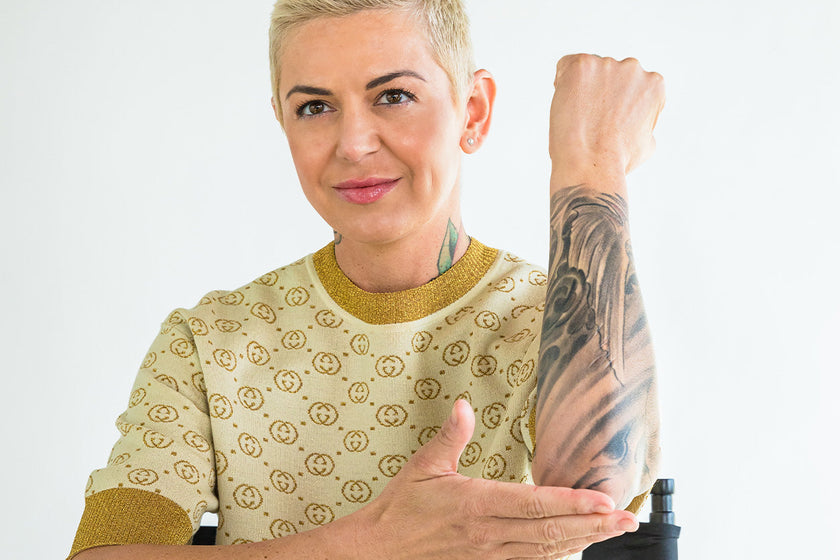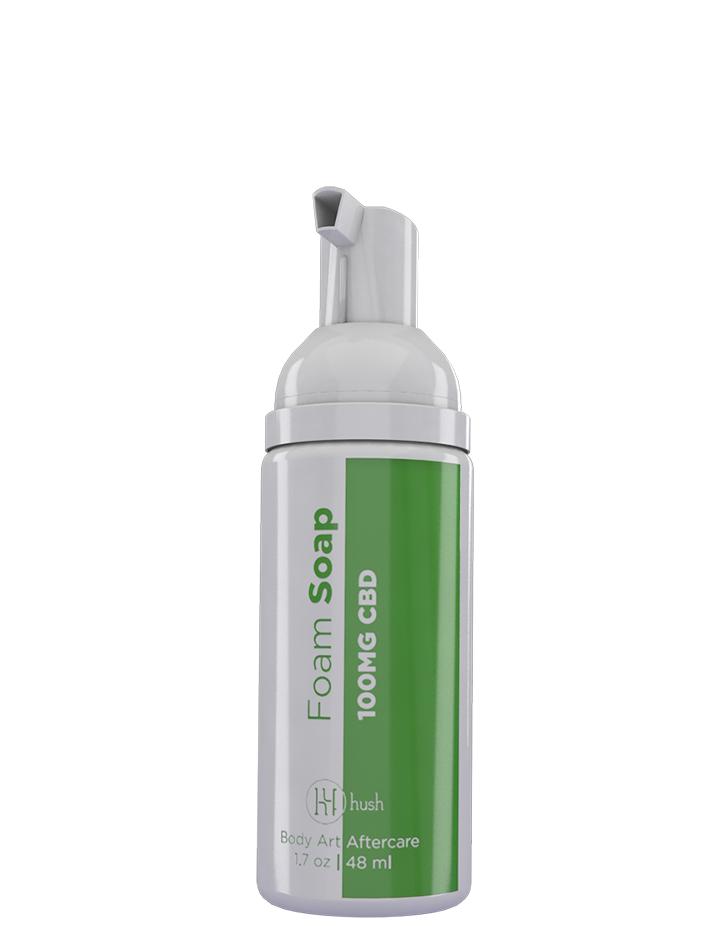Geometric, tribal, traditional, new age, watercolor, blackwork, and the list goes on. There are so many styles of tattoos, and more seem to pop up every year. Some have been around since the beginning of tattooing. Others are more contemporary. A bunch of styles come from painting styles. It’s the evolution of art, baby!
In this guide, HUSH will break down the basic characteristics of quite a few different tattoo styles. That being said, let’s keep in mind that nowadays many artists mix up their work, combining different methods and styles of tattooing.
There are specialists in certain styles for sure, but ultimately, there aren’t really any “rules” with tattooing anymore. You can mix and match and do whatever you want with your design.
This guide will help you put some names to the tattoo art that really speaks to you. If there are two or three art styles that you vibe with, your tattoo could end up being a cool, fluid combination of them. Conversely, if you really want a traditional American tattoo that looks fresh outta the post-war, make sure you find someone who will do exactly that for you.
There’s no limit to tattoo creativity, and you’ll see that plain as day by the end of this article!
American / Traditional / Old School Tattoos
Sailor Jerry, anyone? Heart and daggers? Mom? Traditional tattoos are still the most common tattoos found in the States. This style features clean black lines, vibrant colors (usually primary and secondary colors), and minimal shading.
They are generally two-dimensional tattoos. Old school tattoos are similar in content and should resemble a drawing on the skin.
If you walk into most tattoo shops in the US, you will see traditional-style tattoos lining their walls.
Common Old School Americana Tattoos
- Daggers
- Roses
- Pinups
- Anchors
- Butterflies
- Skulls
- Playing cards
- Birds
These types of tattoos are known to age well. While there’s disagreement over the exact origins of the traditional tattoo style, we see examples of these types of tattoos as far back as the late 1700s.
Japanese Tattoos
Japan has a long, rich history of tattooing. You may have heard about the extremely painful and time-consuming traditional Japanese tattoos of irezumi that are done by hand with bamboo and needles.
This practice was first done on criminals, then the Yakuza (think Japanese mafia) started using tattoos as symbols of status and respect.
In modern-day Japan, getting a tattoo is much more common and much less frowned upon. Some tattoo artists have also chosen to swap the old manual stick-and-poke method for machines.
Japanese tattoos are deeply rooted in Japanese culture. Have you ever perused the ancient Japanese art wing in a museum?
Common Traditional Japanese Tattoos
- Cherry blossoms
- Geishas
- Dragons
- Koi fish
- Stylized trees
- Traditional masks (like hannya)
- Tigers
The other characteristic of Japanese tattoos is their size. Typically they are going to be a more giant tattoo like a whole sleeve or back piece.
Stick-and-Poke Tattoos
Also known as hand-poked tattoos, stick-and-pokes are tattoos done without the use of a machine. They use a tattoo needle attached to some sort of stick, like a bamboo branch, for more control and stability. Then the artist manually sticks and pokes ink into your skin.
A tattoo machine moves a tattoo needle up and down into your skin anywhere between 50 and 3000 times per minute. How fast a human can go depends on their skill level.
Because stick-and-pokes are machine-free, they can resemble dotwork tattoos. It’s way more involved to get a solid line when doing a stick-and-poke tattoo.
Naturally, these tattoos can take a lot of time since a machine can move much faster than a human. Designs with solid colors and filled-in parts are going to cost you — pain and time. The pain can be reduced with numbing gels and numbing creams for tattoo, but the time… that’s on you for picking a stick-and-poke design with a lot of solid color in it!
Common Stick and Poke Tattoos
- Simple shapes (like hearts or flowers)
- Small insignias (like band logos)
- Short words in simple script
- Emoji style art
People tend to choose stick-and-pokes because of cultural importance and immersion. Many people who look for a stick-and-poke artist are getting culturally significant tattoos that their ancestors wore.
In fact, the oldest stick-and-poke artist in the Philippines still offers her services tattooing Filipino tribal tattoos on Philippine natives and trekking tourists alike, and has trained her family in the ancient practice to continue the tradition.
Watercolor Tattoos
Watercolor tattoos are tattoos that look like watercolor paintings, usually with lighter colors and either no hard outlines or one really thick outline. In some ways, they contrast with traditional tattoos, specifically for their lack of strong lines and well-defined structure.
Watercolor tattoos are more contemporary. They are generally done using light pressure, a slower machine, small motions, and diluted ink. Many of us started using watercolor paints in elementary school, but a watercolor tattoo is not nearly as easy as our own first paintings. This style is particularly challenging to do well, but it’s an approach that has been fairly popular recently.
This style is really cool to combine with others to create a really unique tattoo with mind-blowing color effects. For example, if you have a geometric tattoo or linework tattoo, you could theoretically have it accented with watercolor-style color like paint splatter, ink smears, or crayon coloring.
Common Watercolor Tattoo Designs
- Flowers
- Birds
- Butterflies, moths, and dragonflies
- Celestial or planetary scenes
Watercolor tattoos are more about the style of the drawing. The subject matter is only limited by your imagination — go wild with your ideas!
It’s good to note that these tattoos require you to be more mindful about their upkeep. Lighter colors fade faster, so some strong sunscreen and a high-quality aftercare balm can go a long way in keeping your tattoos vibrant and fresh.
Neo-Traditional / New School Tattoos
Neo-traditional tattoos are supercharged traditional tattoos. Neo-traditional tattoo studios have expanded on traditional tattoos with different tattoo designs, bright colors, and incredible shading. Neo-traditional tattoo ideas tend to flirt with realism in a way that the traditional tattoo style would never.
Often large, these tattoos are particularly well suited for the back, arm, or leg. Because of the intensive detail in neo-traditional tattoos, these works of art can take a relatively long time to create.
New school tattoos follow this, and are often bright-colored, prominent, bold, sometimes cartoony or caricature-y, and overall a high-contrast piece you absolutely cannot miss on someone’s skin.
The new school tattoo style has influences as early as the 1970s, but primarily covers styles of the 1980s and 1990s. Beyond the tattoos themselves, new school tattoo style reflects a shift in attitude of tattoo professionals, with a focus on openness and thinking outside the box.
Common Neo Traditional Tattoo Designs
- American traditional tattoos with an updated artistic flair
- Video game characters
- Movie characters
- Mythology tattoos (think Medusa or Neptune)
Neo-traditional or new school tattoos are sometimes even considered an umbrella genre for vibrant, colorful, modern tattoos that don’t quite fit under other categories.
Tribal Tattoos
Tribal tattoos originate from tribal people, and they hold a lot of cultural and spiritual meaning. As the oldest form of tattooing, tribal tattoos date back thousands of years.
Tribal tattoos aren’t related to just one specific group of people like Native Americans or the Maori people of New Zealand. It’s an umbrella term for all tribes and their tattoos.While there are many different cultures with their own styles of tribal tattoos, the ones we see most often today are based on the Polynesian culture.
Tribal tattoos can’t be lumped together as having one specific look, like bold lines or lettering. For some tribal people, tattoos are body art that can be a sort of totem, like a spirit animal or an important crop that has a spiritual meaning. In some cultures, facial tribal tattoos signify relationship status and age. In other cultures, tribal tattoos serve as a connection to the earth, stars, and gods.
The tribal tattoo style is recognizable for its strong block shapes, clean lines, and symmetry. But as with watercolor tattoos, tribal tattoos can be harder to create than you might think. Drawing tribal art on a flat piece of paper can be simple, but when your canvas is a body, there are substantial considerations like making sure the design works in harmony with the muscle and bone structure.
Common Tribal Tattoo Motifs
- Maori art
- Samoan art
- Art unique to various Polynesian cultures
Tribal tattoos are usually very meaningful and represent something, so don’t be the douche that goes out and gets that temporary tattoo-looking spiky band that everyone seemed to get in the early 00s.
Black Ink / Blackwork Tattoos
This is another type of tattoo defined by its style, not its subject matter. The blackwork tattoo style covers a wide range of tattoos, but their common feature is that they’re made using only black ink.
Usually, this kind of tattoo uses huge swaths of black ink and then negative space to create an image. These tattoos can be large or small and simple or intricate.
People often ask how blackwork tattoos and tribal tattoos differ. It’s a good question, because tribal tattoos are generally a form of blackwork tattoos, while the blackwork tattoo genre covers a broader range.
Common Blackwork Tattoo Themes
- Blackwork patches
- Negative space geometry
- Heavy simple shapes
Get ready to sit if you’re thinking about getting a blackwork tattoo. Because so much solid black ink is involved, it will take a lot of time to really fill in those areas — otherwise, they’d be called grey tattoos. And it’s going to be painful too, so make sure you prep whatever body parts are involved with some highly effective tattoo numbing cream or gel.
Realistic Tattoos
This is the style you want to ask for when you want to get a portrait tattoo on your chest. Realistic tattoos look like you’ve got a picture superimposed on your body. Done by the right artist, a realistic tattoo can even rival a photograph with its stunning attention to detail.
This type of tattoo is generally done in shades of black and gray. Portaitism is a type of realistic tattoo style that focuses specifically on portraits with dark outlines, and sometimes the use of color.
Common Realistic Tattoos
- Portraits of people
- Portraits of pets
- Nature scenes
- Animals
It’s a popular tattoo style since they aren’t specific in the subject matter, so you can get a realistic version of whatever you want — a family member, your fur baby, or even a special place you love. These tattoos can be hard to cover up, so make sure you’re confident about what you want.
Fine-Line Tattoos
Fine-line tattoos are becoming more and more popular. These tattoos are typically done with a machine and a low-volume needle, meaning the lines can be thinner, as opposed to a traditional tattoo, where they use a high-volume needle.
High volume means your needle has a bunch of tinier needles inside — 12 is a common average. A low-volume needle has a lot less, usually around one to three needles.
Common Fine Line Tattoos
- Gentle script
- Delicate flowers
- Feathers
Fine-line tattoos are defined by their fine-ass lines! They are not dependent on the subject matter, but can be great minimalist tattoos with small fonts.
Geometric Tattoos
Basically, tattoos with geometric shapes. Usually, a bunch of them overlapping and interlocking to make other shapes.
Sometimes, these are super complex works of art that cover a good portion of the body, like a giant mandala. Other times, they are simpler, smaller designs, or huge, simple designs, or small, complex designs, or even just fillers in a sleeve. Really, anything goes with these — it’s the wearer’s choice!
Common Geometric Tattoos
- Sacred geometry
- Mandalas
- Fibonacci tattoos
Micro Tattoos
Tiiiiiny detailed tattoos. They can look exactly the same as a regular-sized tattoo, just shrunk down in size. Remember Shrinky Dinks? Well, if you don’t, basically what would happen is you draw a picture on a special piece of plastic. Stick that in the oven and bam — a miniature of your drawing smaller than the palm of your hand.
Common Micro Tattoos
- Flowers
- Birds
- Crosses
- Pawprints
- Butterflies
The micro tattoos that people see and want for themselves are these detailed little tattoos that look impossible. Like a detailed drawing of a lion's head on someone's finger or a hummingbird the size of a quarter. These tattoos really push the art of tattooing to its limit, and we are here for it.
Illustrative Tattoos
An illustrative tattoo is often looked at as a piece of artwork that could be drawn on a canvas. If you’re thinking that there are a lot of tattoos that can fit in this category, you’re right. There are many tattoos that can be considered illustrative style.
Often, an illustrative tattoo starts with black outlines in the same way that an artist would start by drawing an outline on canvas or paper.
Common Illustrative Tattoos
- Book cover art
- Comic book pages
- Recreations of paintings
Dotwork Tattoos
Dotwork tattoos are inspired by pointillism, an art style where a ton of dots make up a picture. The spacing of the dots is used to create the picture, so a cluster of dots will create a darker, shaded effect, and more spread-out dots look lighter and brighter.
Some dotwork tattoos don’t have any lines at all. If you look closely at them, you will see that any apparent “lines” are actually a bunch of dots smashed up together.
If you’re a little tattoo nerd you may wonder how that’s any different than maybe a traditional tattoo line, because in the end, all lines are made up of a bunch of needle pokes which could be considered dots. We’re getting deep here, but we know some of you want that extra, and that’s all good!
Anyway, the difference is that with a traditional tattoo, the linework is going to be bold and solid, with smooth, defined edges.
Common Dotwork Tattoo Themes
- Mandalas
- Flowers
- Simple scenes contained within a shape, like a circle or diamond
- Celestial themes
With a dotwork tattoo, the lines are going to look more organic, less defined, and caused by shading. If a dotwork tattoo is done with black ink it ends up appearing more gray than black because the pigment isn’t condensed.
Dotwork is a method that can also be used in any type of tattoo to create some excellent shading work.
Line Work Tattoos
Line work is a generalized tattoo style that can encompass a bunch of very different looks. The one characteristic that draws them all together is the dominating lines that are always there.
Shading isn’t really utilized or is created with lines or dotwork; there are no real rules. Line work is kind of the opposite of dotwork. Line work tattoos use strong, clear lines to develop an image.
Artists who specialize in line work have spent years practicing their lines. They can make straight, laser-sharp lines of any size.
Common Line Work Tattoo Designs
- Simplified portraits
- Clocks and compasses
- Maps
Some of the most popular line work tattoos trending now are contour drawings. They have one non-stop line that curves and loops into whatever design is imaginable. Other line work tattoos can get waaay more detailed, using intricate linework to create landscapes, portraits, and abstract geometrics.
Conclusion
No matter what type of tattoo you choose, your comfort can be a priority. Our line of HUSH products — from gel to creams — can numb your skin, reduce irritation, and reduce redness.
Whether you’re getting a tattoo on a particularly sensitive part of the body, are planning to sit through hours and hours of tattoo work, or just want to take a step to make your tattoo experience more comfortable, HUSH products and the HUSH team are here for you. Check out our tattoo numbing products here.
If you want more tattoo inspiration, check out our blog or find a local artist who specializes in any of the above, then stalk their Insta and book a consultation.
Sources:
Looking at the Most Famous Japanese Artists and Artworks | Art in Context
How Tattoos Work | How Stuff Works
Philippines' oldest tattoo artist -- meet Whang Od Oggay | CNN Travel
A History of Pointillism, the Famous Dot Painting Movement | Art in Context




